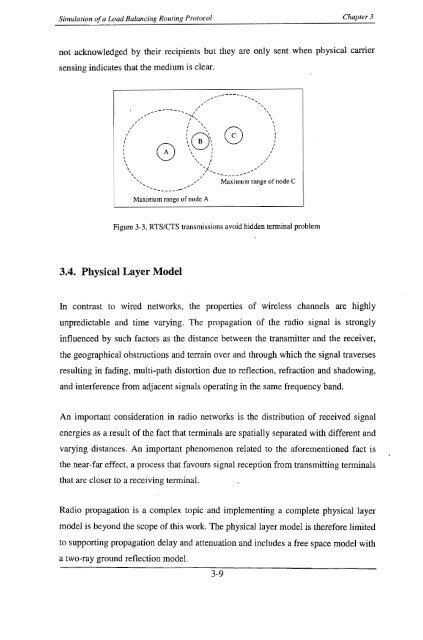Gugrajah_Yuvaan_ Ramesh_2003.pdf
Gugrajah_Yuvaan_ Ramesh_2003.pdf
Gugrajah_Yuvaan_ Ramesh_2003.pdf
You also want an ePaper? Increase the reach of your titles
YUMPU automatically turns print PDFs into web optimized ePapers that Google loves.
Simulation ofa Load Balancing Routing Protocol Chapter 3<br />
not acknowledged by their recipients but they are only sent when physical carrier<br />
sensing indicates that the medium is clear.<br />
Maximum range of node A<br />
Figure 3-3. RTS/CTS transmissions avoid hidden terminal problem<br />
3.4. Physical Layer Model<br />
In contrast to wired networks, the properties of wireless channels are highly<br />
unpredictable and time varying. The propagation of the radio signal is strongly<br />
influenced by such factors as the distance between the transmitter and the receiver,<br />
the geographical obstructions and terrain over and through which the signal traverses<br />
resulting in fading, multi-path distortion due to reflection, refraction and shadowing,<br />
and interference from adjacent signals operating in the same frequency band.<br />
An important consideration in radio networks is the distribution of received signal<br />
energies as a result of the fact that terminals are spatially separated with different and<br />
varying distances. An important phenomenon related to the aforementioned fact is<br />
the near-far effect, a process that favours signal reception from transmitting terminals<br />
that are closer to a receiving terminal.<br />
Radio propagation is a complex topic and implementing a complete physical layer<br />
model is beyond the scope of this work. The physical layer model is therefore limited<br />
to supporting propagation delay and attenuation and includes a free space model with<br />
a two-ray ground reflection model.<br />
3-9
















